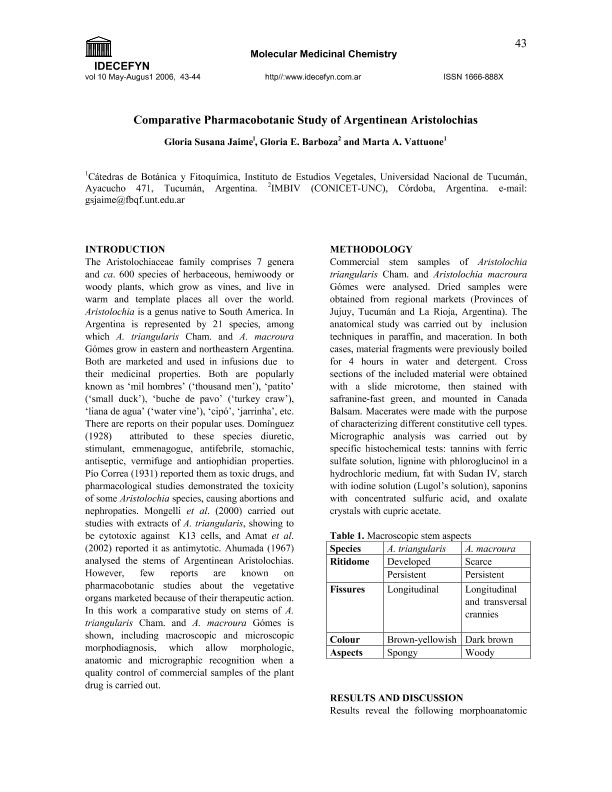Mostrar el registro sencillo del ítem
dc.contributor.author
Jaime, Gloria Susana

dc.contributor.author
Barboza, Gloria E.
dc.contributor.author
Vattuone, Marta Amelia

dc.date.available
2019-09-26T17:12:40Z
dc.date.issued
2006-12
dc.identifier.citation
Jaime, Gloria Susana; Barboza, Gloria E.; Vattuone, Marta Amelia; Comparative pharmacobotanic study of argentinean Aristolochias; Instituto de Investigación de las Ciencias Exactas Físicas y Naturales; Molecular Medicinal Chemistry; 10; 12-2006; 43-44
dc.identifier.issn
1666-888X
dc.identifier.uri
http://hdl.handle.net/11336/84539
dc.description.abstract
The Aristolochiaceae family comprises 7 genera and ca. 600 species of herbaceous, hemiwoody or woody plants, which grow as vines, and live in warm and template places all over the world. Aristolochia is a genus native to South America. In Argentina is represented by 21 species, among which A. triangularis Cham. and A. macroura
Gómes grow in eastern and northeastern Argentina. Both are marketed and used in infusions due to their medicinal properties. Both are popularly known as ‘mil hombres’ (‘thousand men’), ‘patito’ (‘small duck’), ‘buche de pavo’ (‘turkey craw’), ‘liana de agua’ (‘water vine’), ‘cipó’, ‘jarrinha’, etc. There are reports on their popular uses. Domínguez
(1928) attributed to these species diuretic, stimulant, emmenagogue, antifebrile, stomachic, antiseptic, vermifuge and antiophidian properties. Pío Correa (1931) reported them as toxic drugs, and pharmacological studies demonstrated the toxicity of some Aristolochia species, causing abortions and nephropaties. Mongelli et al. (2000) carried out studies with extracts of A. triangularis, showing to be cytotoxic against K13 cells, and Amat et al. (2002) reported it as antimytotic. Ahumada (1967) analysed the stems of Argentinean Aristolochias. However, few reports are known on pharmacobotanic studies about the vegetative organs marketed because of their therapeutic action. In this work a comparative study on stems of A. triangularis Cham. and A. macroura Gómes is shown, including macroscopic and microscopic morphodiagnosis, which allow morphologic,
anatomic and micrographic recognition when a quality control of commercial samples of the plant drug is carried out.
dc.format
application/pdf
dc.language.iso
eng
dc.publisher
Instituto de Investigación de las Ciencias Exactas Físicas y Naturales

dc.rights
info:eu-repo/semantics/openAccess
dc.rights.uri
https://creativecommons.org/licenses/by-nc-sa/2.5/ar/
dc.subject
Aristolochiaceae Family
dc.subject
Herbaceous
dc.subject
Hemiwoody
dc.subject
South America
dc.subject.classification
Bioquímica y Biología Molecular

dc.subject.classification
Ciencias Biológicas

dc.subject.classification
CIENCIAS NATURALES Y EXACTAS

dc.title
Comparative pharmacobotanic study of argentinean Aristolochias
dc.type
info:eu-repo/semantics/article
dc.type
info:ar-repo/semantics/artículo
dc.type
info:eu-repo/semantics/publishedVersion
dc.date.updated
2019-09-13T14:03:34Z
dc.journal.volume
10
dc.journal.pagination
43-44
dc.journal.pais
Argentina

dc.journal.ciudad
ciudad autónoma de buenos aires
dc.description.fil
Fil: Jaime, Gloria Susana. Universidad Nacional de Tucumán. Facultad de Bioquímica, Química y Farmacia. Instituto de Estudios Vegetales. Cátedra de Fitoquímica; Argentina
dc.description.fil
Fil: Barboza, Gloria E.. Consejo Nacional de Investigaciones Científicas y Técnicas. Centro Científico Tecnológico Conicet - Córdoba. Instituto Multidisciplinario de Biología Vegetal. Universidad Nacional de Córdoba. Facultad de Ciencias Exactas Físicas y Naturales. Instituto Multidisciplinario de Biología Vegetal; Argentina
dc.description.fil
Fil: Vattuone, Marta Amelia. Universidad Nacional de Tucumán. Facultad de Bioquímica, Química y Farmacia; Argentina. Consejo Nacional de Investigaciones Científicas y Técnicas. Centro Científico Tecnológico Conicet - Tucumán; Argentina
dc.journal.title
Molecular Medicinal Chemistry

dc.relation.alternativeid
info:eu-repo/semantics/altIdentifier/url/http://www.idecefyn.com.ar/mmcv10/14.pdf
Archivos asociados
